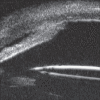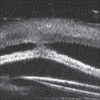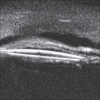Post-penetrating keratoplasty glaucoma
- PMID: 18579984
- PMCID: PMC2636159
- DOI: 10.4103/0301-4738.41410
Post-penetrating keratoplasty glaucoma
Abstract
Post-penetrating keratoplasty (post-PK) glaucoma is an important cause of irreversible visual loss and graft failure. The etiology for this disorder is multifactorial, and with the use of new diagnostic equipment, it is now possible to elucidate the exact pathophysiology of this condition. A clear understanding of the various mechanisms that operate during different time frames following PK is essential to chalk out the appropriate management algorithms. The various issues with regard to its management, including the putative risk factors, intraocular pressure (IOP) assessment post-PK, difficulties in monitoring with regard to the visual fields and optic nerve evaluation, are discussed. A step-wise approach to management starting from the medical management to surgery with and without metabolites and the various cycloablative procedures in cases of failed filtering procedures and excessive perilimbal scarring is presented. Finally, the important issue of minimizing the incidence of glaucoma following PK, especially through the use of oversized grafts and iris tightening procedures in the form of concomitant iridoplasty are emphasized. It is important to weigh the risk-benefit ratio of any modality used in the treatment of this condition as procedures aimed at IOP reduction, namely trabeculectomy with antimetabolites, and glaucoma drainage devices can trigger graft rejection, whereas cyclodestructive procedures can not only cause graft failure but also precipitate phthisis bulbi. Watchful expectancy and optimal time of intervention can salvage both graft and vision in this challenging condition.
Figures







Similar articles
-
[Post-penetrating keratoplasty glaucoma management: report of 73 cases].J Fr Ophtalmol. 2014 Mar;37(3):220-5. doi: 10.1016/j.jfo.2013.06.006. Epub 2014 Feb 18. J Fr Ophtalmol. 2014. PMID: 24559516 French.
-
Glaucoma in penetrating keratoplasty: risk factors, management and outcome.Graefes Arch Clin Exp Ophthalmol. 2013 Jan;251(1):105-16. doi: 10.1007/s00417-012-2065-x. Epub 2012 May 30. Graefes Arch Clin Exp Ophthalmol. 2013. PMID: 22644096
-
Penetrating keratoplasty and glaucoma.Surv Ophthalmol. 2000 Sep-Oct;45(2):91-105. doi: 10.1016/s0039-6257(00)00141-7. Surv Ophthalmol. 2000. PMID: 11033036 Review.
-
Post-penetrating keratoplasty glaucoma: risk factors, management and visual outcome.Aust N Z J Ophthalmol. 1998 Nov;26(4):305-9. doi: 10.1111/j.1442-9071.1998.tb01334.x. Aust N Z J Ophthalmol. 1998. PMID: 9843258
-
Glaucoma after penetrating keratoplasty.Rom J Ophthalmol. 2017 Jul-Sep;61(3):159-165. doi: 10.22336/rjo.2017.30. Rom J Ophthalmol. 2017. PMID: 29450392 Free PMC article. Review.
Cited by
-
Incidence and risk factors for post-penetrating keratoplasty glaucoma.Indian J Ophthalmol. 2022 Apr;70(4):1239-1245. doi: 10.4103/ijo.IJO_1470_21. Indian J Ophthalmol. 2022. PMID: 35326024 Free PMC article.
-
Commentary: Glaucoma following penetrating keratoplasty: A double whammy.Indian J Ophthalmol. 2022 Apr;70(4):1246-1247. doi: 10.4103/ijo.IJO_93_22. Indian J Ophthalmol. 2022. PMID: 35326025 Free PMC article. No abstract available.
-
Challenges in Managing Secondary Glaucoma Post-Repeat Penetrating Keratoplasty in a Developing Country.Int Med Case Rep J. 2023 Mar 18;16:179-185. doi: 10.2147/IMCRJ.S402944. eCollection 2023. Int Med Case Rep J. 2023. PMID: 36968268 Free PMC article.
-
Current Perspectives on Corneal Transplantation.Clin Ophthalmol. 2022 Mar 4;16:631-646. doi: 10.2147/OPTH.S289359. eCollection 2022. Clin Ophthalmol. 2022. PMID: 35282172 Free PMC article. Review.
-
Anterior segment OCT imaging in opaque grafts with secondary glaucoma following tectonic penetrating keratoplasty for perforated corneal ulcers.Eye (Lond). 2011 Nov;25(11):1522-4. doi: 10.1038/eye.2011.210. Epub 2011 Sep 9. Eye (Lond). 2011. PMID: 21904391 Free PMC article. No abstract available.
References
-
- Foulks GN. Glaucoma associated with penetrating keratoplasty. Ophthalmology. 1987;94:871–4. - PubMed
-
- Wilson SE, Kaufman HE. Graft failure after penetrating keratoplasty. Surv Ophthalmol. 1990;34:325–56. - PubMed
-
- Goldberg DB, Schanzlin DJ, Brown SI. Incidence of increased intraocular pressure after keratolasty. Am J Ophthalmol. 1981;92:372–7. - PubMed
-
- Ayyala RS. Penetrating keratoplasty and glaucoma. Surv Ophthalmol. 2000;45:91–105. - PubMed
-
- Irvine AR, Kaufman HE. Intraocular pressure following penetrating keratoplasty. Am J Ophthalmol. 1969;68:835–44. - PubMed
Publication types
MeSH terms
Substances
LinkOut - more resources
Full Text Sources
Medical

